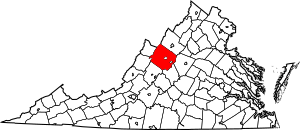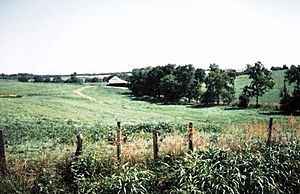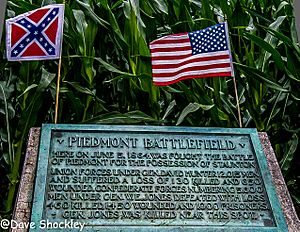Battle of Piedmont facts for kids
Quick facts for kids Battle of Piedmont |
|||||||
|---|---|---|---|---|---|---|---|
| Part of the American Civil War | |||||||
 |
|||||||
|
|||||||
| Belligerents | |||||||
| Commanders and leaders | |||||||
| David Hunter | William E. Jones † | ||||||
| Strength | |||||||
| 8,500 | 5,500 | ||||||
| Casualties and losses | |||||||
| 875 | 1,500 (including 1,000 captured) | ||||||
The Battle of Piedmont was a key fight during the American Civil War. It happened on June 5, 1864, in Augusta County, Virginia. In this battle, Union forces led by Major General David Hunter faced off against Confederate troops. The Confederates were commanded by Brigadier General William E. "Grumble" Jones. After a tough fight, General Jones was killed, and his Confederate soldiers were defeated. This victory allowed General Hunter to take control of Staunton the next day. He then moved towards Lynchburg, destroying military supplies along the way.
Contents
Why the Battle Happened
The Battle of Piedmont was part of a bigger plan by Union Lieutenant General Ulysses S. Grant. He wanted to keep Union armies attacking. This would stop the Confederates from moving their soldiers to other battle areas. In the Shenandoah Valley, General Grant first put General Franz Sigel in charge. But after Sigel lost a battle at New Market on May 15, 1864, Grant replaced him. Major General David Hunter took command of the Union Army of the Shenandoah on May 21.
General Hunter quickly got his army ready. He told his soldiers to find food from the farms in the rich Shenandoah Valley. On May 26, he began moving his army up the Valley towards Staunton. The Confederates had few soldiers left in the Valley. Most of their forces had joined the main Army of Northern Virginia. Only Brigadier General John D. Imboden's brigade and some local reserves were there to stop Hunter. Imboden kept Confederate General Robert E. Lee updated on Hunter's movements. But Imboden's small force could not slow Hunter much. Hunter's goal was Staunton, an important railroad and supply center for the Confederates.
The quick Union advance surprised the Confederates. General Lee asked Brigadier General William E. "Grumble" Jones for help. Jones was in charge of a Confederate department in Southwest Virginia. Jones soon arrived in the Shenandoah Valley with about 4,000 soldiers.
By June 3, the Union army reached Harrisonburg. Imboden had gathered his forces at Mount Crawford. This blocked Hunter's direct path to Staunton. On June 4, Hunter sent a small group of soldiers to Mount Crawford. This was a trick to distract the Confederates. Hunter's main army then moved east to Port Republic, where they camped for the night. General Jones arrived at Mount Crawford and took command of the Confederate forces. When Confederate scouts reported Hunter's move, Imboden suggested they fight at Mowry's Hill. Jones agreed to move his soldiers there to face Hunter on June 5.
The Battle Begins
After a rainy night, Hunter's army marched south towards Mount Meridian. Major General Julius Stahel's cavalry led the way. They pushed back Imboden's Confederate outposts. When Stahel's soldiers reached Mount Meridian, Imboden fought back. But Stahel quickly sent more soldiers and overwhelmed the Confederates. Imboden barely escaped being captured. His brigade, including local reserves, saved the 18th Virginia from being completely defeated. The Confederates then slowly fell back towards the village of Piedmont. Imboden expected to meet General Jones at Mowry's Hill. But he was surprised to find Jones at Piedmont instead. The two commanders talked, and Jones, who was higher in rank, decided to stand and fight at Piedmont.
Jones placed his two brigades of infantry along the edge of a forest. This line stretched from the Staunton Road to the Middle River. He ordered Imboden to protect his far right side with cavalry. Next to Imboden, Brigadier General John C. Vaughn's brigade took position. There was a gap in the middle of the Confederate line. Jones placed two artillery batteries there, including one with 17- and 18-year-old soldiers.
Hunter's Chief of Staff, Colonel David Hunter Strother, described the battlefield. He said the Confederate position was strong. It was on wooded hills that overlooked an open valley. On the Union right, near Piedmont village, the Confederates had defenses made of logs and rails. These were hidden behind a small hill. This allowed them to shoot at Union soldiers moving over the hill from close range.
Fighting at Piedmont
At noon, Hunter's infantry, led by Brigadier General Jeremiah C. Sullivan, attacked. Colonel Augustus Moor's brigade pushed back Jones's advance line. They stopped at the edge of a wooded area. Sullivan ordered an attack, but the Confederates, who were well protected, fought them off. On the other side of the road, Colonel Joseph Thoburn's brigade advanced. They moved through a wooded area towards Imboden's position. They faced heavy artillery fire. Thoburn pulled back to support the Union artillery. During these attacks, Union artillery, led by Captain Henry DuPont, silenced most of the Confederate cannons. Only a few guns with Imboden on the far Confederate right were still firing.
Jones decided to move his left side back to line up with Vaughn and Imboden. But then he changed his mind. Sullivan sent two more regiments to help Moor and ordered another attack. This attack was also stopped. This time, the Confederates attacked back. But the 28th Ohio and some dismounted cavalry, using special repeating rifles, held their ground. This forced the Confederates to fall back to their defenses. Jones then moved his forces to launch a big attack against Moor's brigade. He ordered Vaughn to move most of his brigade to the left. The 60th Virginia Infantry moved from its spot, leaving a large gap in the center of the Confederate line completely open.
The Union Victory
The Union soldiers noticed the open gap on the Confederate right side. Hunter ordered Thoburn's brigade to attack this weak spot. Thoburn's soldiers quickly moved close to the Confederate left before they were seen. They then broke through the Confederate line. At the same time, Moor's brigade attacked the Confederate front. Jones tried to fix the situation. He brought up the Valley Reserves, who slowed Thoburn's advance. But they could not stop it. Jones rushed towards a small group of rallying Confederates. He then charged towards the attacking Union soldiers. A Union bullet hit him in the head, killing him instantly.
The Union forces pushed the Confederates towards the bluffs of the Middle River. This split the Confederate army into two parts. At the bluffs, soldiers from Thoburn's and Moor's brigades, helped by Stahel's Cavalry, captured almost 1,000 Confederates who were not wounded. A part of Captain John McClanahan's Virginia horse artillery stood its ground near Piedmont village. They slowed the Union advance and barely escaped capture.
On the Staunton Road, the 1st New York Veteran Cavalry chased the defeated Confederates. However, another part of McClanahan's artillery and some of Vaughn's brigade quickly set up along the road. When the New Yorkers chased the fleeing Confederates, this Confederate rear guard opened fire. They caused heavy losses to the Union cavalry. This made the Union soldiers less eager to chase further. Even though at least 1,500 Confederates were lost, this rear guard action allowed the rest of the army to escape. Vaughn learned he was now the highest-ranking officer because Jones had died. He followed Imboden's advice. Hunter's army gathered the prisoners and cared for the wounded at Piedmont. The Army of the Shenandoah camped there for the night. They had lost nearly 900 men killed and wounded. The next day, Hunter's army became the first Union army to enter Staunton.
Brave Actions: Medal of Honor Recipients
Some soldiers showed incredible bravery during the battle. They were later awarded the Medal of Honor.
- Private Thomas Evans, from the 54th Pennsylvania Infantry, shot a Confederate officer who was trying to rally his troops. He then fought the soldier carrying the flag of the 45th Virginia and captured the flag from him.
- Musician James Snedden, also from the 54th Pennsylvania Infantry, picked up a rifle and joined the attack. He captured Colonel Beuhring Jones, who was the commander of the 1st Confederate infantry brigade.
- Major General Julius Stahel was hit by two bullets while leading his cavalry into the fight. He had his wounds treated at a field hospital and then returned to lead the final cavalry charge.




